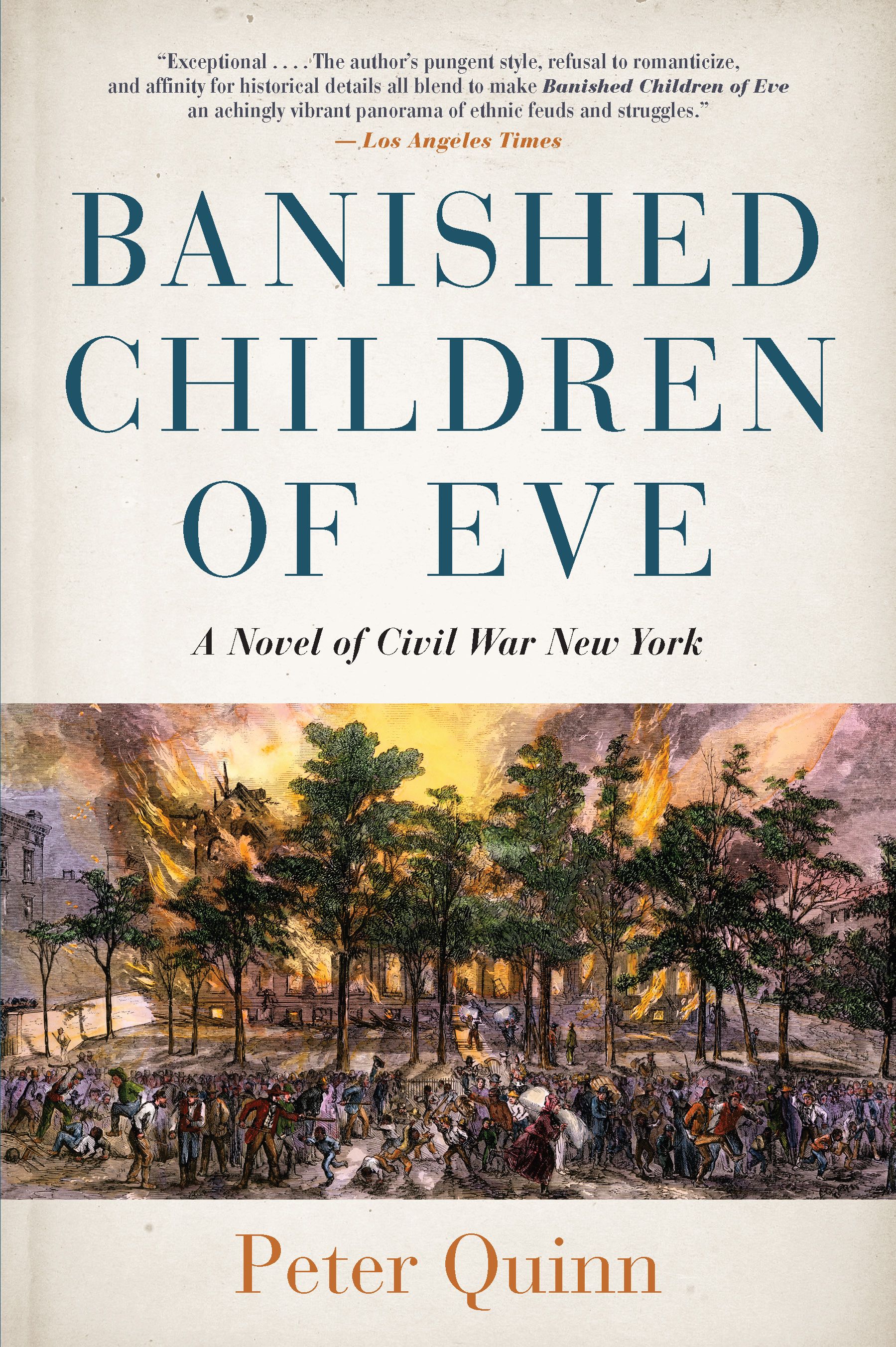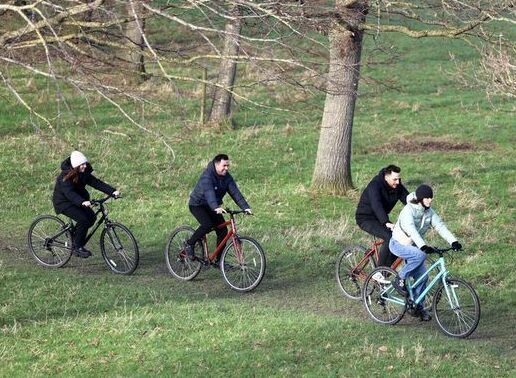Part II
I had high hopes for Charles Dineen. Lots of people did. He went to work each day, leaving behind his wife and three children in the apartment at 97 Orchard St. By the year 2000, he’d been long a specter, but one, if you closed your eyes, you could imagine easily enough walking the hallways of No. 97 -- a specter of substance and some promise.
The store clerk was one of those Irish-surnamed individuals being tracked by researchers at the Lower East Side Tenement Museum.
Another was Jeremiah Sullivan, a common enough name, but quite probably the same one who was sponsor to one of Charles and Bridget Dineen’s children at nearby St. Mary’s Church.
In the end, Charles slipped from the researchers’ grasp; although the stories told at the museum are in part speculative, and allow the visitor to create a back story, if need be, the museum required certain core facts that it couldn’t quite nail down.
Later a new name emerged, that of Joseph Moore, a Dublin-born waiter, whose story formed the basis of the long-sought Irish apartment and opened in 2008. In the meantime, I’d gotten to know the other apartments as an educator myself. By the advent of the Moores, though, I’d moved on. I hadn’t forgotten the Dineens, however, as they were my introduction to the museum -- I'd written a piece for the Echo about the search for an Irish family. I also felt that theirs had the potential to add something to the existing apartment stories that the Moore story could not.
Now that there’s another Joseph Moore, in the same occupation, and also a resident of Lower Manhattan, I can see the possibilities of the proposed “hybrid” story. The Irish Joseph, and the story of his struggles, can be renewed and enhanced by the other one, who is Black.
In Part I a couple of weeks back, I pointed out that the Tenement Museum flap was predicated upon a misreporting and misunderstanding about what its mission was and also argued that the change to its programming is entirely within the remit of what an established, respected museum can reasonably do.
That leaves the question: how did this even became an issue at all? A prominent academic in the Irish community commented to me in the last couple of days that it’s “just crazy” what can be politicized these days. As to the “how” in the case of the Tenement Museum, well, maybe there’s a clue in the fact a New York Times article about programming issues back in June was filed in the “Art & Design” section, while in November Peter Van Buren’s provocative “Woke Claims a Museum” was posted on the conservative Spectator World website under “Politics."
Let’s not forget that in the midst of multiple crises facing the new administration and lawmakers in Washington – such as the nation’s crumbling infrastructure and the first pandemic since the end of World War I -- Fox News was for a time obsessed with Dr. Seuss. That ridiculous and bizarre controversy involved a decision that was arguably, like the museum’s, about marketing, but which also intersected with issues of sensitivity and inclusion. And both controversies could only be weaponized with the help of a great deal of distortion and omission of context.
Lots of folks who aren’t conservative or right-leaning are concerned about issues of freedom of speech and academic freedom in controversies where the terms “woke” and “political correctness” and “cancel culture” crop up. It’s hard sometimes, though, to figure out what’s real through the fog.
Maybe it was obvious to some reading Van Buren’s original piece that it had a particular agenda; he even managed to get Critical Race Theory into the first sentence. It have been less easy by the time it was processed through an Ancient Order of Hibernians’ statement, the Irish-American media coverage of that and additional reporting in selected dailies.
A friend emailed from Europe to tell me that the number of Black actors depicting soldiers and officials in a BBC program about Roman London drew letters of protest about “political correctness.” It turns out the actors were there due to historical correctness.
Still, my friend, who is very much on the left, finds the “new ‘woke’ even more annoying than PC.” No doubt, he sees the negative charge of “political correctness” as ridiculous in many cases, and perhaps justified in others. Like many with his politics, he feels that those who dwell too much on identity are losing the plot; he would prefer emphasis on universal values like equality and fairness, and finding common ground between people.
The problem here is that the values of tolerance and inclusion, ones we associate with the Tenement Museum, are very much grist to the mill for commentary in some sections of conservative media in the U.S.
Van Buren’s central claim was that the Tenement Museum was “shoehorning” in the Black experience at the expense of white immigrants – and that because Joseph Moore hadn’t actually lived at No. 97, recreating his and Rachel’s apartment, which was actually elsewhere (and would be clearly labeled as such), was an “affront.” He compared the relaying of the story of a living and breathing Black man of the 19th century to the telling of Spiderman’s life story at the same location.
This is firmly in the tradition of a certain type of response to change: resist, first of all, and then cast some or all practical efforts designed to address inequality and promote inclusion as “special treatment” and “handouts.”
The reality is the Tenement Museum has been shoehorning in everyone since the beginning, including the Irish. When you think of it, here was a museum whose initial appeal — its main appeal, even, for a long time -- was that it was in the old Jewish Lower East Side, the emotional heart of the Diaspora in America for generations. And yet, almost straight away its first president and co-founder Ruth Abram reached back to tell the almost forgotten story of Little Germany (Catholics, Lutherans and Jews) that immediately preceded it, and then moved forward to bring in Italians (mostly Catholic) and so on.
Abram’s mother was a convert from Methodism to her father’s Judaism and she has roots in Ireland and England. In the 2000 piece for the Echo, I wrote: “She also knows what it is to be an outsider. She was raised in a Jewish home in Atlanta, the daughter of the civil rights lawyer Morris Abram. Martin Luther King Jr. was a visitor to her family home when she was a child. Her parents advised her not to mention the famous guest at school, where she’d already experienced anti-Semitism.”
Finding a way to tell the African-American story in Lower Manhattan had been a concern for Abram and her co-founder right from the beginning and continued to be in the years after that, as that New York Times piece last June confirmed.
Van Buren would have that such issues were only taken up in recent times. In his Spectator World, he told how he worked for the museum as an educator for a time in 2016, only to witness a “small, elegant, good place” transformed by the politics of the moment into a hotbed of woke, which drove him out.
That and several other parts of his account stretch credulity, but as to the point about it being “woke” overnight -- in 2018, I followed the new tour at 103 Orchard St. telling the Puerto Rican (again Catholic) and Chinese stories, as the guest of Fordham’s Prof. Christina Greer, a recently appointed board member and author of “Black Ethnics,” and I found the basic ethos and approach recognizable from my time as an educator at 97 Orchard St. from 2001 through to 2004.
Van Buren would have it also that, in the museum’s perspective, “Irish immigrants went from suffering anti-Catholic discrimination in Protestant New York to being murderers of innocent blacks during the 1863 Draft Riots.
“Never mind that the Irish family spotlighted by the museum lived there in 1869 and had no connection to the riots. We were on a woke jihad.”
This was a point that was taken up in one Irish-American media editorial, without any evidence that these two are ever linked on a tour.
The tenement building that is 97 Orchard St. was being built in 1863 and open for rent in 1864 and so it’s an obvious thing to mention while giving the historical backdrop of Civil War-era New York. I likely did myself at least on occasion.
Educators have a certain leeway in their approach, especially in broader strokes and the Times report suggested it was they, not the museum’s managers, who were bringing up the Draft Riots; clearly, it’s not part of any official script with relation to the Moores.
The piece “After the Riots: New York’s Black Community Responds and Rebuilds” is worth consulting in this regard.
“While [the Rev. Henry Highland] Garnet and others agree that Irish immigrants participated in the riots, they would point to instances of aid and support provided by Irish neighbors and organizations during and after the riots,” it says, “The Black presses would instead lay most of the blame on anti-war Democratic politicians and the city’s numerous pro-confederate and pro-slavery newspapers for deliberately inciting violence.”
The person named is the Reverend Henry Highland Garnet, who’d been born into slavery in Maryland before escaping with his family New York in 1824, and as leader of the Shiloh Presbyterian Church in lower Manhattan was a spokesperson for the Black community and a leader of the national anti-slavery movement.
The article, which appears on the Tenement Museum’s website, tenement.org, hardly accords with picture of the kind of “woke jihad” that Van Buren tried to paint.
I seem to recall from my years at the museum that the best-known scholarly work on the Draft Riots suggested that those wards in Tammany Hall control saw no rioting, which might be an interesting point to make about how local political machines played a huge part in the assimilation process.
This is what was potentially interesting about Charles: he was a store clerk and you could speculate a backstory of an upwardly mobile “urban pioneer,” as the Tenement Museum would’ve called someone from a rural background (and a Dineen likely came from a tenant farm in Kerry or Cork). Involvement in politics might be a way of having some contact and status with his neighbors in Little Germany.
Joseph Moore was from my own city of Dublin, and therefore not an urban pioneer. When you think of wait staff in a 19th century context a Paris-set impressionist painting might come to mind. It sounds, too, more like a job a modern immigrant would have. Joseph doesn't really fit any cliches.
I followed the “Irish Outsiders” tour a couple of times (including once when the educator was among the museum’s best by reputation, an Irish-American schoolteacher), but it never quite worked for me in the way the others did. Again, remember that researchers only had a few Irish families to choose from, compared to those of German- and Yiddish-speaking backgrounds. The later apartments – Italian, Puerto Rican and Chinese – would have the huge advantage of having been created with the help of recollections of family members who lived in them.
Now with two waiters maybe there’s more scope for raising common issues like the biases that they faced. The AOH’s concern is that anti-Catholicism is getting written out of 19th-century American history, but one could argue that in this context the hybrid model opens up real possibilities for it being central to the narrative.
Artists, writers and musicians have been more open to embracing the complexity of New York City’s history, including the Draft Riots – think of Peter Quinn’s “Banished Children of Eve” and “Paradise Alley” by Kevin Baker, and Larry Kirwan’s musical “Hard Times.” These same people have been regulars as guest speakers and performers at the Tenement Museum, alongside Colum McCann, Mick Moloney, the late Nuala O’Faolain, the late Danny Cassidy and Joseph O’Connor (the author of a fictional piece set in 97 Orchard St.). Pete Hamill was a big favorite at the museum (though like some of the above he wasn’t on board with its failure to recognize the right of educators to organize). I introduced Hamill at a reading at the museum’s bookstore one evening and arranged for former reporter Maurice “Mickey” Carroll to interview him about his life and work. The store sold a record number of books on that occasion.
The same folks, incidentally, were on the frontline, alongside others such as musician Joe Hurley and the local parishioners, when the Archdiocese went in to bulldoze St. Brigid’s Church and indeed made a fairly good start on it (with a big hole in the back wall and smashed stained-glass windows).
Quinn’s father, Peter Sr., was an elected official whose roots were in the tenements of the Lower East Side. During a successful run for Congress in 1944, he described in a Daily News article his loyalty to the New Deal as being rooted in the experience of his father before him, an immigrant and a “coppersmith by trade [who] for a half a century stood on the thin front-line of those unsung heroes who led the long, heart-breaking uphill fight for the rights of the workingman.”
In “On the Irish Waterfront,” James T. Fisher describes the “social context” that formed the Rev. Philip A. Carey, director of the Jesuits’ Xavier Labor School on Manhattan’s West Side from the late 1930s.
“[I]t was his father’s debilitating experience of urban working class life that was seared in the memory,” he said of the priest who was born into an immigrant family in the South Bronx.
John Carey was a trolley motorman with the Third Avenue Transit Company for 37 years. He was granted only two holidays each year: one reserved for a family trip to Coney Island, the other to attend a Communion breakfast.
Fisher writes, “The ‘brutality of the job was incredible,’ his son recalled. The men enjoyed no collective bargaining rights and received no compensation for injuries sustained on the job. In the autumn of 1916, John Carey participated in a bitter, protracted and violent strike of the Amalgamated Association of Street Car Employees; the family subsisted on tea and toast.”
When the elder Carey returned to work, he wore a union button under his lapel. During that strike, he found some employment on the West Side docks. “He worked the barbed wire and cement because no one would handle that,” the son said. “The breathing was awful. The barbed wire tore all his clothes. There was a wonderful priest at that time at Guardian Angel, Father McGrath, who told my father after two days, ‘You’re not the man for this type of work. Get back. Don’t stay around here.’”
Fisher reports later, “Just before his son was ordained, John Carey urged him never to forget ‘the grizzly guys like me who need you,’ men who struggled to maintain their dignity amid unrelenting toil.”
We’ve largely forgotten them, though. It seems easier and more comfortable to relate history as a series of biases and slights, which are then bravely overcome. But often families, while aware of that past and clinging strongly to their ethnic and religious identity, faced over the generations the more elemental challenges connected to making a living.
It was with this history in mind that an Irish-American labor activist emailed some thoughts last week about the fake row over the Tenement Museum: she wished people were “more generous of spirit” and that they’d try harder to seek out the “shared experiences that bind us.”








